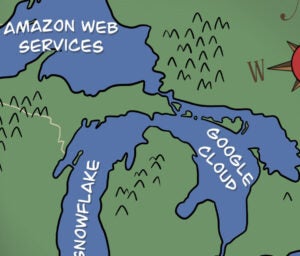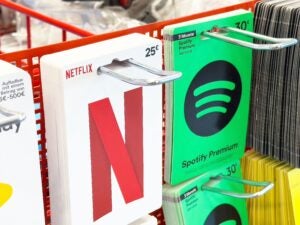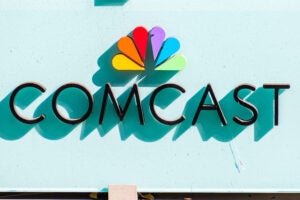 “Data-Driven Thinking” is written by members of the media community and contains fresh ideas on the digital revolution in media.
“Data-Driven Thinking” is written by members of the media community and contains fresh ideas on the digital revolution in media.
Today’s column is written by Dave Zinman, chief operating officer at RadiumOne.
Back in 1994, a group of my Stanford business school classmates and I shared a fascination with the web and immediately recognized its business potential. We clicked from page to page – an act then known as “surfing” – to see what we’d stumble upon, with the hope of possibly unearthing ways of making money in the nascent but burgeoning virtual world.
In late October 1994, I ran across a small rectangular image perched above the content on HotWired, the website for Wired Magazine and one of the web’s earliest and most popular sites. It was the first banner ad, from AT&T, and it validated many of the thoughts we had, the most important of which was: Where the eyeballs go, advertising will follow.
It was my clarion call. Together with another classmate, we set out to invent a device to deliver relevant ads to users. Alas, the first ad server was born. Twenty years ago, in the summer of 1995, we tested it out on a little-known company – Condom Country – for whom we developed an ad for free. It went so well that soon we caught the attention of – and ad dollars from – some better-known businesses, such as Intel and Saturn, the now-defunct automaker.
Although the ad server’s role is straightforward, the industry that has sprung up around it has been anything but simple. Ad tech has become increasingly complex as marketers strive to reach consumers across a growing array of devices. The dizzying amount of data produced by each channel provides an opportunity to reach consumers on a deeply personal level, but also threatens to overwhelm marketers grappling with its interpretation and actionability.
Following its introduction 20 years ago, the ad server quickly became the fundamental infrastructure for digital advertising, with many predicted and surprising consequences.
We knew digital advertising would grow, but who could have predicted global digital ad spending would reach $140 billion in just 20 years? We knew digital ads eventually would be highly targeted, but we didn’t anticipate all the privacy concerns that would soon arise. We also knew digital ads would be more relevant than traditional ones, so it didn’t follow that user engagement would actually plummet.
Back in October 1994, 78% of visitors clicked on that AT&T ad. Today, the average ad takes more than 1,000 views to get a single click.
Disruptive Changes
No doubt the last 20 years has seen some dramatic changes from the humble, if provocative, beginnings of the ad server. Since that fateful day, there have been a number of disruptive waves that have irrevocably changed the digital ad market.
Reach and the birth of the ad network: Initially, portals were the only way for advertisers to achieve reach. The ad network offered advertisers a way to bypass the portal and still achieve significant reach.
Performance and the advent of search: Search came along and taught advertisers that they could spend in an accountable and measurable way. This bled into display, with the advent of retargeting and other more exact methods of relevancy for consumers. Now a majority of display advertising has back-end measures that are used to judge success, such as the effective cost per action.
Increased inventory and scale: From portals to networks, and now programmatic, buying through a well-integrated demand-side platform can provide truly global reach and scale. Leading vendors today can bid on 50 billion bid requests a day, or enjoy more than 200 opportunities to serve an impression for each and every digital consumer in the US.
Diversity of channels and the multidevice consumer: Consumers access more content, entertainment and communications solutions on more devices than ever before, ranging from PCs and laptops to tablets and smartphones. With the introduction of smartwatches, other wearables and eventually a myriad of home-, auto- and work-related devices, the Internet of Things will continue to create ripple effects on the advertising market. Think things are going to get easier for advertisers? Ad tech will only grow more complicated and diverse in order to incorporate access to consumers through whatever devices they choose, and to enable advertisers to optimize spend across devices. Advertisers will face higher-stakes choices in balancing the need to consolidate platforms and leverage best-in-class innovation.
The crumbling walls of the data garden: Initially data was only available from portals, which pioneered behavioral targeting but operated as their own “walled gardens” and did not share data. Today, advertisers can bring their own data or acquire data freely on the open market. They can also link offline and online data, which allows for more relevant and targeted ads, benefiting advertisers and consumers alike. And just as the walls came down on data, dominant players have been trying to erect more walls of their own, creating new, proprietary data gardens.
Will these walls become prisons for advertisers or places that combine unique capabilities and exits to the open market? In the near term, bet on prisons.
In Retrospect
Sure, there have been plenty of changes over the last 20 years, but at its core, the ad server largely remains the same – deciding which ads get served to which user at what time and in what context.
The increasing array of channels and devices create more challenges for marketers. The expanding data set those channels generate create more opportunities for them. In the end, the brand and the consumer both stand to gain from the waves of disruption that have already occurred and those to come.
The only constants in the world of digital advertising are the waves shifting it – some predicted, some surprising.
And to think the engine powering all of this began with some kids at Stanford – and a guy selling condoms online.
Where will we be in another 20 years?
Follow Dave Zinman (@davebehappy), RadiumOne (@RadiumOne) and AdExchanger (@adexchanger) on Twitter.













